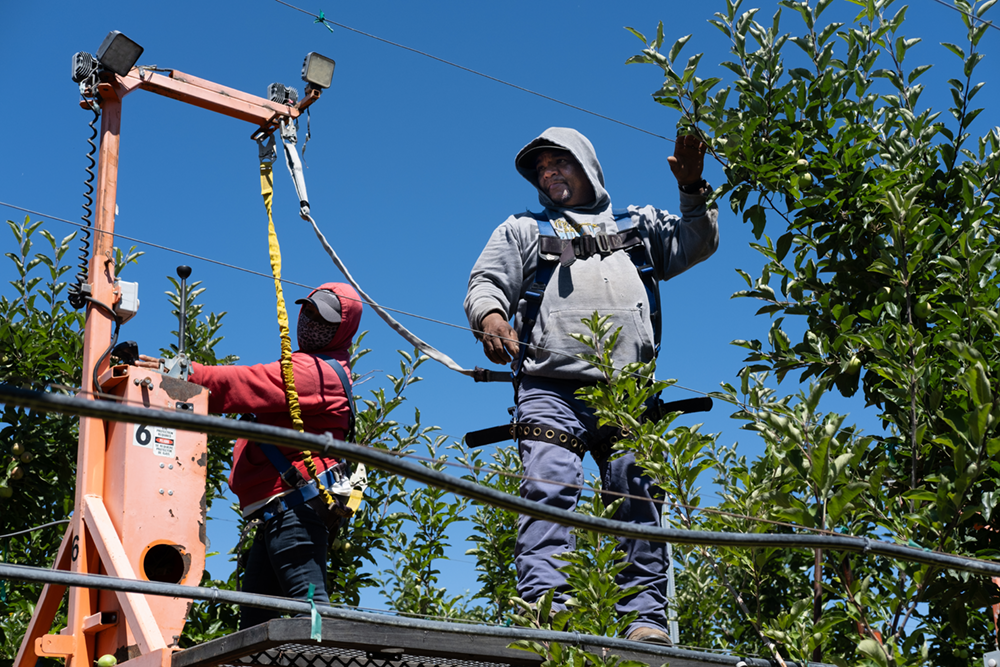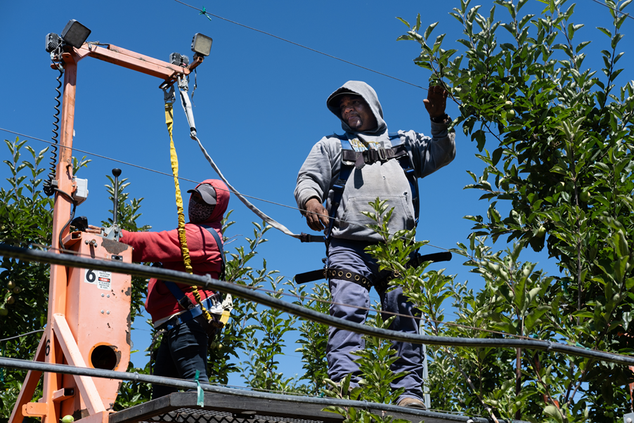BY CALEB HAMPTON
AgAlert
A sprawling heat dome put more than 30 million people across the Western U.S. under excessive heat advisories last week, triggering warnings from the National Weather Service about the danger of extreme heat to human health and potential impacts on “heat-sensitive industries.”
Over the past two decades, heat illness awareness and prevention has become a major focus for California farms that rely on workers to harvest crops and perform other essential work during the hottest months of the year.
“As we see seemingly warmer summers and earlier heat waves, it has become more important than ever for employers to make sure they’ve got things like shade, water and rest periods for employees,” said Bryan Little, director of labor affairs for the California Farm Bureau and chief operating officer of the Farm Employers Labor Service.
Last week, as temperatures soared into triple digits, farmers drew on years of experience to implement safety measures.
In Firebaugh, farmer Joe Del Bosque employed someone to drive around his melon fields in a truck loaded with water and ice. After seeing the forecast, the Fresno County farmer canceled work on the hottest day of the week and told the workers to come on Saturday instead, when it was about 10 degrees cooler.
Del Bosque converted old cotton trailers, once used to haul the crop to cotton gins, into mobile shade trailers. He outfitted them with benches and awnings so that his workers can take shaded rest breaks.
In Lodi, an apple thinning crew moved through farmer Jeff Colombini’s orchard on self-propelled platforms with water coolers mounted on them. The machines eliminate the need for workers to climb and carry ladders, reducing exertion, a key factor in maintaining safe body temperatures and preventing heat illness, according to health experts.
When the outdoor temperature reached 91 degrees, sensors in Colombini’s orchard sent an alert to his phone. The farmer then called his labor supervisor and told him it was time to stop work. “The goal is to have everyone out of the field before the temperature reaches 95,” Colombini said.
Farmers and farm labor safety experts in California said heat-illness awareness and preparedness have evolved since the state established the nation’s first heat-safety law for outdoor workers in 2005. The policy was adopted after farmworker deaths in the Central Valley.
“There has been a remarkable and important effort,” said Aaron Lange, who grows winegrapes in Lodi, referring to advances in heat illness prevention on California farms. “We take each job very seriously—what their exposure to risk is—and we talk about it and try to minimize that exposure.”
According to the National Weather Service, heat kills more people in the U.S. than any other kind of extreme weather, including disasters such as hurricanes, floods and wildfires.
California’s Heat Illness Prevention Standard requires that outdoor workers have access to water, shade and rest when the temperature rises above 80 degrees. When it hits 95, the highest level of the heat-safety law goes into effect, with more frequent breaks required.
The law also mandates trainings for supervisors and field workers, an acclimatization process and a reliable line of communication between farms and local emergency services.
“We have definitely seen an evolution where there is a desire to have this information and to share it with workers,” said Angelina Ceja, vice president and chief education officer of Modesto-based AgSafe, which conducts heat-safety trainings on farms across the country.
Years ago, when AgSafe began its trainings, it scheduled them in the evenings after employees got off work. Then farmers began inviting the organization to farms to conduct the required heat-safety trainings. Lately, “We’ve had requests from growers about coming out and doing additional trainings,” Ceja said. “The desire is definitely there.”
In the summertime, heat-safety equipment is a defining feature of the Golden State’s farmland. “Driving through California, whether it’s on the coast or in the valley, I see shade trailers, portable water and obviously restrooms,” Ceja said. “It can be quite different, just in terms of what I see, as I drive around and visit other places.”
California remains one of just four states with laws protecting outdoor workers from heat illness. But that could soon change.
In 2021, the Department of Labor’s Occupational Safety and Health Administration announced it would develop a federal heat standard to protect workers. An agency official told The Washington Post it plans to publish its proposed standard later this year.
There is evidence California’s heat standard and the efforts of the state’s farmers have made a difference. A 2021 study by researchers at the University of California, Los Angeles, and Stanford University found heat-related injuries for outdoor workers in California fell by roughly a third since the state’s heat-safety law took effect.
According to new research, employers may also benefit from implementing heat protections for workers. Globally, heat can reduce farmworkers’ physical work capacity by as much as 30%, according to a study published this year by researchers from California, Arizona, Washington, the United Kingdom and Australia. Extreme heat also increases rates of illness and injury for workers.
“Farmers and employers have been developing good safety policies and practices to make work safer for their employees,” said Del Bosque, who is a former AgSafe director and whose parents were farmworkers. His personal connection to farmworkers gave him “a lot of passion,” he said, for doing everything possible to keep them safe in the field.
“It’s really important for us because our workforce is very important,” Del Bosque said. “We could not do what we do in California, producing fruits and vegetables and so forth, without our workforce. And it’s important to take care of them.”
— Courtesy of the California Farm Bureau Federation






